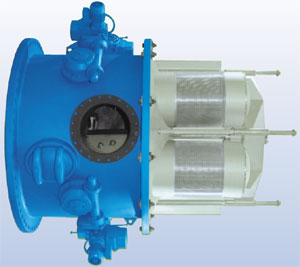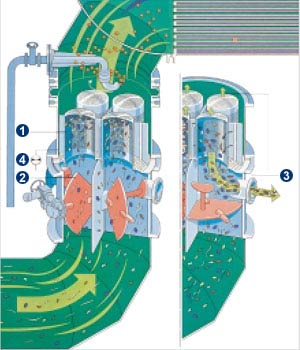Debris Filter with Redundant Safety Technology
The PR-BW 400 is an Automatic Backwash Filter for the separation of macro fouling (debris) from liquids, especially from cooling waters for turbine condensers and heat exchangers. The main characteristics and outstanding features of this filter are its 4-fold redundant operational safety together with its capability to reliably discharge even extremely large particles.
With regular filtration degrees of 4.5 - 9 mm, the filter is applicable for huge volume flows of up to 100,000 m3/h and beyond. For the first time the world over in this class, filter cleaning has been realized according to the principle of “pressure-relieved backwash” (PR-BW). The clear increase in efficiency has marked a new performance standard in the high-end zone. Because of those remarkable features the PR-BW 400 has acquired a firm footing on an international level - at all places where permanent availability, absolute reliability and safety enjoy top priority, for instance in cooling water circuits of power stations and nuclear power plants.
Field of Application

- PR-BW 400 Debris Filter in a power station
- Operation in seawater, brackish water, river water, or other water sources
- for the protection from macro fouling of objects installed downstream, such as condensers and heat exchangers
- in open cooling circuits with once-through cooling or recirculative cooling systems (cooling tower operation)
The PR-BW 400 mainly comprises the valve housing and the filter section (1) fixed thereto. The diameter of the valve housing regularly corresponds to that of the pipe where the filter will be mounted. The valve housing is installed into the existing pipe by making use of its flanges at both sides. The filter section (1) does not require a housing shell of its own; it is inserted downstream into the existing pipe and directly connected, without gaps, to the downstream flange of the valve housing. The valve housing is divided into four segments by partition walls. Each segment is provided with a debris discharge valve (2) that, for backwash purposes of the respective segment, can be turned by 90° via an actuator. Firmly mounted to each debris discharge valve (2) is a discharge flap for the discharge pipe, so that once the debris discharge valve is turned by 90° the discharge pipe (3) is simultaneously released or closed.
The filter section (1) as well is divided into four segments by partition walls, so the segmentary geometry of the valve housing is carried on in the filter section. Every filter section consists of the filter bottom and a generously dimensioned filter basket for the storage of even bulky debris particles. In deviation from the standard design the filter baskets can be equipped with safety valves that open in the case of overload, independently and without additional energy.
A differential pressure measuring system (4) monitors the adjustable backwash point and initiates the backwash procedure. In addition to that, backwashing can be started by an overruling timer. All functions necessary for the automatic filter operation, such as, for control, protection, and signalling, are contained in a separate control panel.
For maximum effectiveness, the PR-BW 400 is installed directly upstream of the condenser or heat exchanger. During filter operation all discharge valves (2) are in open position. The coarse particles that are transported in the cooling medium and would block tubes and tube sheets - also those growing in the intake canal - are retained in the filter section (1) depending on the relevant filter fineness.
The accumulation of macro fouling in the filter segments is controlled by the differential pressure measuring system (4). Once the pressure drop caused by the accumulation of coarse particles reaches a pre-set value, first a debris discharge valve closes by turning by 90°, and at the same time - due to the firm junction - the discharge valve for the discharge pipe (3) opens and releases the pipe. The pressure difference caused by the opening of the discharge pipe (3) then initiates a backwash flow from the relevant filter segment in the discharge pipe. By the temporary isolation of the relevant filter segment from the influx of the medium the particles to be separated are now pressure-relieved (PR) which enables them to be lifted off very effectively from the screening surface and washed out into the discharge pipe by the backwash (BW) flow. Immediately upon backwash the discharge flap of the relevant filter segment closes again.
By successively continuing this procedure for the remaining three filter segments the complete backwash of the filter is reached. Given the fact that filter backwash is performed segment by segment, the medium flow to the heat exchanger is at any time safeguarded without interruption.
Technical Data
| series: | PR-BW 400 |
| volume flow: | 2,000 - 100,000 m3/h |
| connecting diameters: | DN 1,000 - DN 3,400 |
| filter fineness degrees: | 4.5 - 9 mm (standard) |
| filter element: | perforated stainless steel sheet |
| material of housing: | steel, rubberlined |
| temperature: | max. 80 °C |
| debris discharge capacity: | 0.3 ltr/m3 (depending on type of debris) |
| control: | programmable controller |
| options: | safety valve; FilterOptimizer; Remote Monitoring Service |
| special execution: | for nuclear requirements |
Installation
The PR-BW 400 Debris Filter is normally installed directly upstream of the condenser or heat exchanger to be protected. The backwash process necessitates a pressure drop in the discharge pipe. Normally the discharge pipe of the filter can be arranged in a by-pass to the heat exchanger and re-fed into the cooling water flow downstream of the same, as the necessary pressure drop is caused by the heat exchanger itself.
The backwash water can be discharged atmospherically by making use of the static overpressure downstream of the filter. If the pressure differential is not sufficient, the backwash water can also be guided in a pipe via a booster pump.

- PR-BW 400 Debris Filter in backwash position
Technical Features and Benefits
Redundant Safety
- The PR-BW 400 design includes a 4-fold redundancy by using four independent drives. In the case of breakdown of one drive, filter operation can be maintained by the remaining drives.
- For reasons of availability and safety, systems that may be struck by abruptly occuring macro fouling in extremely large quantities, systems in nuclear power stations with high demands in terms of safety technology, and cooling water pumps with high zero pumping head, can be equipped with filter sections with safety valves. Once a pre-set pressure differential at the filter section has been reached, the safety valves open automatically without requiring additional energy.
- Automatic locking control with prescreening systems connected upstream (opening of bypass valves) and with cooling water pumps (at start-up operation) can be arranged for.
- The PR-BW 400 is used in seismic areas of the world and is especially rated and documented for this application.
- Option: Operational filter monitoring by Remote Monitoring Service.
Flexible Installation
- The filter system (discharge flap and filter section) can be installed in any position, that means horizontally, vertically, and under any angle to fit the space conditions of the pipes.
- In limited space conditions the filter segments may also protrude into the condenser waterboxes.
Performance on Top Level
- Compared to previously common filters with turbulence technology as flushing technology, the technology of the “pressure-relieved backwash” of the PR-BW 400 places the PR-BW 400 in the high-performance class.
- Just in cases where the dimensions of occuring debris are unknown, the PR-BW 400 excels as a safe and powerful solution. By the generous dimensioning of the four filter segments the filter can absorb even extremely large fouling quantities. As the filter does not require any additional, separate isolating devices in the discharge pipe - that may sometimes restrict the diameter - it creates best preconditions for cases in which the maximum debris dimensions can be determined only very vaguely.
- The filter is prefitted for the installation of the FilterOptimizer, the intelligent tool for optimizing the backwash point.
TAPROGGE Care & Comfort Package
Quality right from the Start
- Performance by TAPROGGE as per DIN EN ISO 9001
- Safety of design by fulfilling the requirements of the European Pressure Equipment Directive 97/23/EC
- Application of a management system for safety, health and environmental protection (SCC)
- Standard documentation; documentation upon customer’s request, respectively
- The use of extremely corrosion-resistant materials with long lifetimes safeguards the preservation of the value of investment.
Compatibility by IN-TA-CT® Modules
- The PR-BW 400 filter is a modular element of IN-TA-CT®, our integral principle for the optimization of cooling water circuits.
- By combination with a TAPROGGE prescreening system upstream and a TAPROGGE tube cleaning system type D2 downstream, an effective overall solution according to IN-TA-CT®, our integral system, presents itself for the protection from micro and macro fouling. Without interfaces - and inclusive of the TAPROGGE System Guarantee.
Competence and Experience out of one Hand
- Application consultancy, project management, fabrication, installation and commissioning of the PR-BW 400 filters are available from TAPROGGE out of one hand.
- With more than 12,000 successful applications, TAPROGGE can make use of its application-technological experience in its special field that stands unparalleled the world over. This plus of competence is indispensable for difficult media and unknown cleaning behaviour.
- In addition to that, the cooling water test circuits of TAPROGGE’s Technological Centre allow a particularly reliable and cost-efficient simulation of site conditions.
Comprehensive Operator Support by IN-TA-S®
- By the installation and commissioning of the PR-BW 400 filters, operators have immediate access to IN-TA-S®.
- By IN-TA-S®, TAPROGGE takes care of the operator in all questions of operation and maintenance. Scope, duration and frequency of the care can be determined by the operator.
- Particularly quick support is available to the users of our Remote Monitoring Service.



